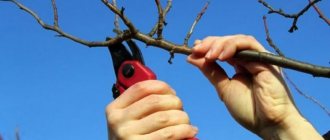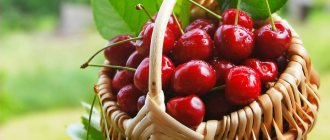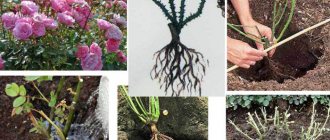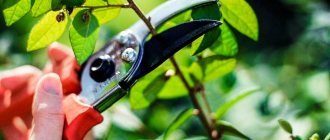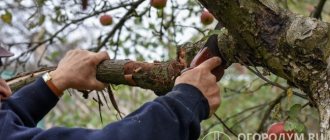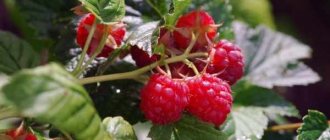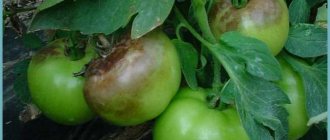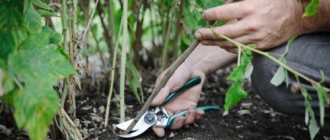Almost every gardener has apple trees in his garden.
There are a huge number of varieties of this garden crop; apple trees grow almost everywhere, on any soil and bear fruit well.
But to achieve high productivity, apple trees need to be given a lot of attention and proper care..
This article will help clarify the question of when you can prune apple trees in the fall.
This includes not only watering, spraying and adding necessary nutrients to the soil. An important condition for abundant fruiting is also the timely removal of excess branches, in other words, pruning .
Apple trees that are deprived of proper crown formation become thickened. The leaves, trunk and roots are deprived of access to sunlight and air ventilation, and this, in turn, affects the quality and quantity of fruit.
Also, old plants are pruned for the purpose of rejuvenation , because over the years the old branches stop bearing fruit. As a result of pruning, such branches are replaced by young ones.
Compliance with the specific procedures for pruning an apple tree will guarantee the creation of a beautiful crown and an excellent harvest.
Basic principles of crown formation
Proper pruning makes it possible to form the optimal shape of the apple tree crown for specific conditions, ensure better and faster growth of the tree, and increase the yield and quality of apples. Regular pruning encourages trees to bear fruit regularly, produces an adequate amount of fruiting wood and (if necessary) increases the proportion of young shoots. Apple and pear trees have mostly short fruiting shoots.
Tools: pruning shears, loppers, garden saw
However, not everyone knows how to prune apple trees. Below are some rules for pruning apple trees that you should definitely pay attention to:
- We get rid of unnecessary branches. First remove branches growing at sharp angles; they break faster under the weight of the fruit.
- Trim branches that unnecessarily shade others, cross, or fall on neighboring branches.
- Remove branches that compete with the center and side conductors.
- When forming the crown of an apple tree, you need to get rid of shoots and branches that are diseased or attacked by pests.
- Apple trees, especially vigorous varieties on tall rootstocks, form very tall crowns. Trees with too high a crown should be limited - caring for tall trees is difficult and inconvenient. It is easier to limit trees on low- or medium-growing rootstocks, which must be taken into account when purchasing seedlings.
- With severe pruning, strong shoots begin to appear, protruding vertically upward, which are usually called “tops”. These shoots should be removed every year because they can cause severe compaction and shading of the crown. It is better to remove the “tops” in the summer – the wounds will heal faster.
- It is better to carry out work on dry days so that the wounds dry out faster.
- Branches can only be trimmed with disinfected tools to prevent trees from becoming infected with diseases. Especially after pruning diseased trees.
- Wounds that form after removing thick branches should be properly protected from possible attack by pathogens and excessive drying. In gardening stores you will find suitable products, for example, copper-based. They also use garden pitch and oil paint on drying oil.
Common mistakes
Many gardeners make mistakes when pruning apple trees in the fall:
- You should know that pruning is carried out not only in spring, but also in autumn. During the growing season, many tops develop on the branches that need to be removed. If you ignore the advice, these branches will become large and replace skeletal shoots. There will be no fruiting.
- You can’t leave stumps - it’s better to cut into a ring. The remaining part of the shoot will most likely rot and collapse.
- Fresh thin sections should be left for a couple of hours and only then covered with garden varnish. This precaution is necessary in order not to provoke rot. If the wound exceeds 3 cm, then treatment with oil paint or varnish is carried out after a week.
- Weak pruning leads to slow growth of young branches. Heavy pruning stimulates the development of fattening branches. Therefore, it is recommended to carry out an average.
When is the best time to prune?
It is advisable to carry out this work at least 2 times a year. The timing of pruning apple trees is very important. A tree that is pruned at the wrong time may become sick, freeze, bear no harvest, or produce very little fruit. Pruning old and young apple trees with a well-formed crown is different, and the methods of formation also differ. The generally accepted deadlines are as follows:
- the main pruning is carried out during the dormant period (after leaf fall - before the start of the growing season) - the procedure is carried out annually in autumn, winter or spring (the optimal period depends on the climatic zone);
- auxiliary (summer) – from July to August.
Timing for pruning fruit trees and shrubs in autumn in the Moscow region
Unfortunately, it is not possible to give a definite answer to the question of when it is better to prune trees in spring or autumn. There are different recommendations for different cultures. In autumn, you can prune winter-hardy trees (apple trees and some varieties of pears), fruit bushes and vines that are prone to early bud awakening (red and black currants, gooseberries, grapes), as well as raspberries and blackberries that complete their life cycle.
Methods for cutting shoots and branches
There are the following methods for pruning apple tree branches:
- on the ring;
- on the kidney;
- stepped (for large branches).
On the ring
At the base of the branches, a ring-shaped influx of bark is clearly visible, consisting of active tissues that can relatively quickly close the wound with new bark. When the branch is completely removed, the so-called “ring” pruning is carried out to the ring.
How to make a cut correctly:
- The branch is cut exactly along the top of this annular bead at a slight angle.
- You cannot cut off the ring by going deep into the wood, as this will remove the most active bark tissue and the wound will take longer to heal.
- You cannot leave a stump above the ring, otherwise the tree will not be able to cover the wound with bark or will take a long time to overgrow, and the wood may begin to rot at the cut site if the branch is large.
On the kidney
The method is used when shortening annual shoots during crown formation. Correct pruning for a bud is done like this: the cut is made above the bud, which “looks” outside the crown so that the shoot growing from it does not thicken the tree. Some gardeners prune to the inner bud; this leads to thickening of the crown and worsens the air and light conditions of the tree.
Scheme. The figure shows: the inner bud “looks” into the crown and the outer bud “looks” out from the crown.
Stepped
It is used when you need to cut down a large, heavy branch. To prevent the branch from breaking off when cutting, creating a large wound on the trunk, it is sawed in several stages:
- First, an incision is made at a distance of several centimeters from the ring, with a depth of about a third of the thickness of the branch.
- Then an incision is made at the top of the branch at a distance from the ring a little further from the bottom cut. As a result, the branch is cut without breaking or injury.
- The remaining stump is cut into a ring with a hacksaw. Cutting a large branch creates a large wound; it needs to be treated with garden varnish.
Precautionary measures
Beginning gardeners should take into account that any pruning, including autumn pruning, is stressful for the tree. Excessive zeal can harm the health of the apple tree.
Before starting gardening work, tools should be disinfected.
When removing branches, especially those located inside the crown, it is important not to damage the bark of the trunk and neighboring branches.
When cutting large branches, you should not leave stumps. Over time, any stump begins to rot. Rotting processes spread to healthy tissue, penetrating into the core of the trunk and shortening the life of the tree.
To stimulate healing, sections exceeding 1 cm in diameter must be treated with garden varnish.
To prevent recurrence of the disease and infection of other plants, it is recommended to immediately burn the removed branches.
Types of pruning
There are several types of pruning, differing in purpose.
Crown formation
Formative pruning of a young apple tree should begin immediately after planting. It is very important to form the crown correctly. This will make it easier to collect fruit and further care.
How to prune an apple tree to form a crown is written below, in the section - Activities according to the years of a tree’s life.
From the very beginning, you need to remember about the height of the trunk - this is the distance from the ground to the first branch at which the formation of the crown will begin. The stem gives the plant the shape of a tree, not a bush, and makes it easier to care for and harvest.
Maintain a distance of approximately 80 cm from the ground to the first branch. Form the crown of the apple tree in the form of a free spindle (a modern intensive option for low-growing rootstocks) or a pyramid (a sparse-tiered form is a traditional option). The correct shape will ensure uniform illumination of the fruits, and the branches will not break under their weight. Formative pruning is done during the dormant period - in autumn, after leaf fall, in winter (in some climatic zones) or in early spring - before the growing season.
Sanitary
This pruning is carried out in the spring. The purpose of the event is to remove dried, diseased, damaged shoots, which can become a source of infection and a wintering place for pests (in the bark of old branches). During this period, root shoots and shoots that appear on the trunk (below the main, skeletal branches) are also cut out.
After work, cut branches must be burned or disposed of outside the site to prevent the spread of infections and pests.
Rejuvenating
The purpose of this technique is to rejuvenate the tree. Rejuvenating pruning of an old apple tree includes radical cutting of perennial, skeletal branches in order to stimulate the development of dormant buds and subsequently form a new tree frame from these shoots.
We will talk about this in more detail below in the section – Old tree.
Thinning or regulating
Young trees (5-6 years old) are thinned out sparingly, since they have a smaller volume of shoots and the sun's rays penetrate more easily into the center of the crown. Older and mature trees require more severe thinning. Trees with too thick a crown due to lack of sunlight are more susceptible to diseases. They take longer to dry after rain, and water retention can lead to the development of fungal diseases. Thickening also contributes to the fact that flower buds do not form in the center of the crown, which leads to a decrease in the number of fruits, a decrease in the taste and marketability of apples (weak coloring of red varieties).
The procedure is carried out during the rest period. As a rule, it is combined with formative (if the garden is young and the formation of the crown continues) and sanitary pruning. During annual crown thinning, approximately 20% of shoots and branches are cut off.
Goals:
- give more light to the center of the crown, create optimal lighting and ventilation conditions;
- support the formation by removing branches competing with the conductors.
During the work, branches are removed, including competing conductors, weak shoots, and diseased ones.
After the procedure, the crown may seem sparse, but in the summer, when new shoots appear, the tree will thicken again.
Further care
After the procedure, the tree needs care, which consists of a number of activities :
- cleaning the trunk of mosses and lichens with a plastic spatula and treating with copper sulfate (500 g per bucket of water);
- moisture-charging watering, ensuring abundant flowering in spring and fruiting (for an adult apple tree you will need 4–6 buckets of water, the ground should be moist to a depth of 1 m);
- fertilization: 1-2 buckets of rotted manure, 50 g of superphosphate;
- digging the soil to a depth of 15 cm;
- mulching: cover the tree trunk circle with a thick layer (up to 15 cm) of peat, pine needles, moss or chopped tree bark;
- whitewashing the trunk in late autumn.
To protect against insects and other pests, winter treatment is carried out with preparations (“Aktara”, “Aktellik”, etc.).
Types of pruning by season
Winter and spring
Pruning apple trees at the end of winter or spring is carried out for fruit-bearing apple trees in order to thin out the crown and maintain formation. It provides adequate lighting, good ventilation and humidity levels, and reduces the risk of fungal diseases. When a tree has the optimal number of branches, its fruits become more beautiful, larger, and tastier.
In winter, pruning should not be done in severe frosts; branches that are fragile from frost may break.
Winter pruning of the crown of apple trees is carried out at the end of February - April (depending on the region) during the dormant period - until sap flow begins. After the sap begins to flow, the buds begin to swell and it is undesirable to prune the branches, because the risk of damage to the buds is high. The optimal timing is different in different regions:
- in the south - you can prune the apple tree in February;
- in the middle zone, Moscow region - from mid-March;
- in cold regions - in April.
The most frost-resistant varieties are pruned first. During the work, frozen branches are cut off, which can be identified by the bark - it becomes dry and darker in color. When cut, the frozen branch is brown, with a brown cambium under the bark. The living branch is distinguished by smooth bark with a characteristic color for the variety; when cut, it is light in color with a green cambium.
Photo. Apple tree branches, live and frozen
Also in the spring, thinning is done, the tops and branches growing inside the crown are cut off. Sections of large branches are painted over with drying oil paint.
Drawing. Pruning an apple tree in spring for beginners
in autumn
Recently, more and more gardeners have been thinning apple trees in the fall, when the plant enters a dormant state and the leaves fall off, but before the onset of severe frosts. However, autumn work can lead to a decrease in the frost resistance of the plant. This method is usually used in the southern regions; in cold regions it is better to postpone events to spring.
Autumn pruning of an apple tree is similar to spring pruning and is performed in the same way. Sanitary, thinning and shaping pruning is carried out.
If autumn pruning is performed, then in the spring only sanitary pruning is done.
The timing of autumn pruning depends on the phase of tree development; wait until the tree enters the dormant phase. The procedure is carried out after leaf fall:
- in central Russia - late October - mid-November;
- south - end of November.
You need to finish pruning before frost.
Pruning (step-by-step) apple trees in the fall for beginners:
- Sanitary pruning – removal of diseased, broken, dead, disease- and pest-damaged branches.
- Thinning cutting - remove weak, twisted shoots growing towards the center of the crown, as well as tops and part of the overgrowing wood into a ring (completely removing).
- Maintaining the created crown shape:
- all conductors in each tier should be located at the same height; conductors that are too tall should be shortened;
- the conductors of the upper tier must be located above the conductors of the lower tier; if this is not the case, we shorten the conductors of the lower tier;
- We make sure that the central conductor of the tree has no competitors in height; if competitors appear, we remove them; the center conductor should be the tallest.
Treat sections of large branches with garden varnish or paint.
Pruning the crown of an apple tree in autumn - video
Useful tips
Useful tips from experienced gardeners:
- regularly inspect the cuts after circumcision; you may need to re-treat them with garden varnish;
- trim no more than 1/3 of the crown even if the tree is in a neglected state (in the latter case, it is better to divide the procedure into several seasons);
- whitewash the tree trunk with chalk before it is five years old, and then with lime;
- wrap the trunk with burlap to insulate and protect the bark from hares and rodents;
- make a support next to young trees to protect from strong winds.
These measures will allow the work to be carried out as gently as possible for the plant , which will have a beneficial effect on its condition and fruiting.
Recommended timing
There are two rules for pruning apple trees in the fall:
- Begin pruning before the leaves fall completely.
- Finish before the first frost.
It is also important to consider the region in which the trees grow. For example, apple trees in the Urals need late varieties that are considered frost-resistant, since the climate there is harsh and cold. Choose locally selected varieties as they are already adapted to the specific climate. However, in the Moscow region, the tree pruning scheme is standard - it begins with the formation of the tree crown, and the planted varieties are exactly those that should be pruned in the fall - dwarf and columnar apple trees.
Some gardeners use lunar calendar values to determine pruning times. Lunar cycles influence all biological processes, and fruit trees are no exception - sap flows are more active during the hours of the waning Moon and in all zodiac signs except Pisces, Cancer and Aquarius.
Unfavorable days are the days of the waxing moon - the movement of the sap goes up, and the seedlings are too sensitive - and when the moon changes its cycle - full moon and new moon.
